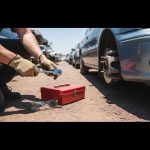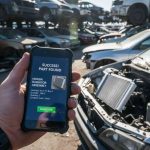Yes, even tho this post is in August, winter is just around the corner, and it’s time to prepare your car for the cold weather. This article is a must-read for anyone looking to winterize a car and ensure a safe and smooth winter driving experience. From checking your tire pressure to protecting your battery, we’ve got you covered with a comprehensive checklist. Read on to learn how to prepare your car for winter and avoid any unexpected car breakdowns.

Why Winterize A Car?
Winterizing your car is essential to ensure that it performs optimally in winter conditions. Cold temperatures can affect various parts of your car, including the battery, coolant, and tires. By winterizing your car, you can:
- Avoid Car Trouble: Cold weather hits hard on the battery and cooling system. Prepare your car for winter to prevent unexpected breakdowns. Regular inspections and maintenance can prevent issues like battery failure and coolant leaks, which are common in winter.
- Ensure Safe Winter Driving: Proper tire pressure and tread depth are crucial for driving in winter conditions. Winterizing helps in maintaining traction on ice and snow. Checking tire pressure and using winter-specific tires can significantly improve your car’s grip on slippery roads.
- Extend Car Life: Regular winter care helps in keeping your car in good condition, protecting it from harsh winter conditions. This includes regular oil changes, checking antifreeze levels, and inspecting wiper blades, all of which contribute to your car’s longevity.
How to Check Your Tire Pressure for Winter Driving?
Tire pressure is vital for safe winter driving. Here’s how to ensure your tires are ready for winter:
- Check Tire Pressure Regularly: Cold weather can cause a drop in tire pressure. Make sure to check it at least once a month. A tire pressure gauge can be purchased at any auto parts store, and many gas stations have them available for use.
- Consider Winter Tires: If you live in an area with heavy snow and ice, consider switching to dedicated winter tires for better traction. Winter tires are designed with special tread patterns that provide better grip on snow and ice compared to all-season tires.
- Inspect Tread Depth: Adequate tread depth is essential for grip on slippery roads. Use a tread depth gauge to ensure your tires are winter-ready. The tread depth should be at least 1/16th of an inch for safe winter driving.
Wiper Blades: Are They Ready for the Freeze?
Wiper blades play a crucial role in maintaining visibility during winter storms. Here’s how to prepare them:
- Replace Worn-Out Blades: Inspect your wiper blades for wear and tear and replace them if needed. Worn-out blades can leave streaks on the windshield, reducing visibility during snow or rain.
- Use Winter Windshield Fluid: Add a bottle of washer fluid antifreeze to the reservoir to prevent freezing. This special fluid is designed to withstand lower temperatures and helps in clearing ice and snow from the windshield.
- Check Wiper Operation: Make sure your wipers are working correctly to handle snow and ice. Test them before the winter season starts to ensure they are functioning properly.
Coolant Check: Is Your Car Ready for Winter?
The cooling system is vital to prevent freezing and overheating. Here’s how to winterize it:
- Check Coolant Level: Ensure that the coolant level is appropriate and top it off if needed. Low coolant levels can lead to overheating, even in winter.
- Inspect Radiator Cap: A faulty radiator cap can cause leaks. Check and replace it if necessary. A properly functioning radiator cap maintains the right pressure in the cooling system, preventing leaks and ensuring efficient operation.
- Use Antifreeze: Add the right amount of antifreeze to prevent freezing in cold temperatures. Antifreeze lowers the freezing point of the coolant, preventing it from freezing inside the engine and causing damage.
Gas: How to Prepare Your Car’s Fuel System for Winter?
Winterizing your car’s fuel system is essential to ensure smooth operation in cold weather. Here’s how to prepare:
- Keep the Gas Tank Full: During winter, it’s advisable to keep your gas tank at least half full. This prevents condensation from forming inside the tank, which can freeze and cause problems. Make sure your car is ready for winter by regularly checking the gas level.
- Use Fuel Additives if Necessary: In extremely cold temperatures, consider using fuel additives that prevent freezing. These additives lower the freezing point of the fuel, ensuring that your car starts even when the temperature drops.

Tread and Tread Depth: Why Is It Crucial for Winter Driving?
Tread and tread depth are vital for maintaining traction on icy and snowy roads. Here’s why they are crucial:
- Inspect Tread Depth: Adequate tread depth is essential for grip on slippery roads. Use a tread depth gauge to ensure your tires are winter-ready. The tread depth should be at least 1/16th of an inch for safe winter driving. Make sure you buy tires with proper tread depth if your current ones are worn out.
- Check Tread Patterns: Winter-specific tires have unique tread patterns designed to channel snow and ice away from the tire’s surface. This design helps in getting your car moving on slippery surfaces, providing better control and safety.
Tip: Don’t buy used tires at local junkyards as they could have imperfections and crack during a winter freeze.
Winter Checklist for Vehicles: What Should You Include?
Preparing a winter checklist for vehicles ensures that you cover all essential aspects of winterizing your car or truck. Here’s what to include:
- Regular Inspections: Schedule regular inspections of your vehicle to ensure everything is in working order. This includes checking the battery, coolant, wipers, and other essential parts.
- Emergency Kit: Prepare a winter car emergency kit with essentials like blankets, food, water, and a flashlight. This kit can be a lifesaver if you get stranded in winter weather.
Consider Winter Tires: Are They Necessary to Winterize Your Car?
Winter tires can make a significant difference in winter driving. Here’s why you should consider them:
- Better Traction: Winter tires provide better traction on snow and ice compared to all-season tires. If you live in an area with harsh winter conditions, consider installing a set of dedicated winter tires for improved safety.
- Temperature Consideration: Winter tires are made of a softer rubber compound that remains flexible in cold temperatures. This flexibility allows the tires to grip the road better, ensuring safer driving when the temperature drops.

Winterizing Your Car: A Comprehensive Checklist
Winterizing your car involves several steps. Here’s a checklist to get your car ready for winter:
- Check Tire Pressure and Tread Depth: Regularly inspect tire pressure and tread depth to ensure optimal traction and safety on icy roads.
- Inspect Wiper Blades and Windshield Fluid: Replace worn-out wiper blades and use winter-specific windshield fluid to maintain clear visibility.
- Examine Cooling System and Antifreeze Level: Check the coolant level and add antifreeze as needed to prevent freezing and overheating.
- Protect Your Battery from Cold Weather: Cold weather can reduce battery efficiency. Keep the battery posts clean and consider using a battery warmer in extremely cold areas.
- Prepare a Winter Car Emergency Kit: Include essential items like blankets, food, water, and a flashlight to stay safe if stranded.
- Follow Winter Driving Safety Tips: Adhere to safe driving practices like slowing down and keeping distance to prevent accidents in winter conditions.
Winter Tires vs. All-Season Tires: What’s the Difference?
Understanding the difference between winter tires and all-season tires is essential for winter driving. Here’s a comparison:
- Winter Tires: Designed for harsh winter conditions, winter tires offer better traction on snow and ice. They are made with a softer rubber compound that remains flexible in cold temperatures, providing better grip.
- All-Season Tires: Suitable for various weather conditions but may not provide optimal grip in heavy snow. While convenient, all-season tires may not perform as well as winter tires in extreme winter conditions.
Protect Your Battery from Cold Weather
The battery is susceptible to cold weather. Here’s how to protect it:
- Inspect Battery Posts and Terminals: Clean any corrosion on top of the battery to ensure proper connection. Corrosion can impede the flow of electricity, leading to starting problems.
- Test Battery Strength: Buy a battery tester that works to check the battery’s health. Regular testing can help you identify a weakening battery before it fails.
- Keep Cables Handy: Carry jumper cables in your car in case of a winter breakdown. Knowing how to use them can be a lifesaver if your battery dies in a remote area.

Winter Car Emergency Kit: What to Include?
Being prepared for winter emergencies is vital. Here’s what to include in your winter car emergency kit:
- Blankets and Warm Clothing: Keeping warm is essential if stranded in cold weather. Include blankets, gloves, and hats in your kit.
- Flashlight and Batteries: A flashlight can be crucial for signaling help or making repairs in the dark.
- First Aid Kit: Include basic first aid supplies to treat minor injuries.
- Food and Water: Pack non-perishable snacks and water to sustain you if stranded for an extended period.
- Snow Shovel and Ice Scraper: These tools can be essential for digging your car out of snow or clearing ice from the windshield.
- Tire Chains and Traction Mats: Tire chains can provide extra traction in deep snow, and traction mats can help if stuck on ice.
| Category | Item | Description |
|---|---|---|
| Fuel System | Gas | Keep the tank at least half full; consider fuel additives in extreme cold. |
| Tires | Tread and Tread Depth | Inspect tread depth and consider winter tires for better traction. |
| Checklist | Winter Checklist for Vehicles | Include regular inspections and an emergency kit. |
| Tires | Consider Winter Tires | Use winter tires for improved traction in harsh winter conditions. |
Winter Driving Safety Tips
Driving in the winter requires extra caution. Here are some winter driving tips:
- Slow Down: Reduce speed in icy conditions. Driving too fast on icy roads can lead to skidding and loss of control.
- Keep Distance: Maintain a safe distance from other vehicles. Stopping distances are longer on slippery roads, so give yourself extra space.
- Avoid Sudden Movements: Sudden turns or stops can cause skidding. Make slow and deliberate movements to maintain control.
- Stay Informed: Check weather forecasts and road conditions before heading out. Being aware of potential storms or icy conditions allows you to plan accordingly.
Winter Windshield Care: How to Prevent Winter Breakdown?
Taking care of your winter windshield is essential to prevent breakdowns. Here’s how:
- Use Winter Windshield Fluid: Prevent freezing by using the right fluid. Regular windshield fluid may freeze in extreme cold, so use a winter-specific formula.
- Inspect Wipers Regularly: Ensure they are in good condition to handle winter weather. Regular inspections and replacements ensure clear visibility during storms.
- Carry Extra Fluid: Keep an extra bottle of washer fluid antifreeze in your car at all times. Running out during a storm can severely hinder visibility.
Summary
Winterizing your car is essential for a safe and smooth winter driving experience. Remember to:
- Check tire pressure and tread depth regularly: Proper tire maintenance ensures safe driving on icy roads.
- Inspect and replace wiper blades if needed: Good wipers are essential for clear visibility during winter storms.
- Protect your battery from cold weather: Regular inspections and cleaning can prevent winter battery failure.
- Prepare a winter car emergency kit: Being prepared for emergencies can be a lifesaver if stranded in winter.
- Follow winter driving safety tips: Adhering to safe driving practices helps prevent accidents in winter conditions.
By following this comprehensive guide, you can ensure that your car is ready for winter and enjoy a trouble-free winter season. Stay safe and happy winter driving!
FAQs
How do I prepare my car for winter?
To prepare your car for winter, make sure you have enough gas in your tank, check your car battery, and switch to winter tires if necessary.
What should I do to winterize my car?
To winterize your car, start by checking the tread depth on your tires. Make sure they have enough tread to provide sufficient traction on snowy or icy roads.
What is the importance of having a car battery ready for winter?
A car battery can lose its power faster in cold temperatures. It’s important to have a fully charged and properly functioning battery to ensure your car starts reliably in the winter.
When should I switch to winter tires?
It is recommended to switch to winter tires once the temperature consistently drops to 45 degrees Fahrenheit (7 degrees Celsius) or below. Winter tires provide better grip and traction in cold weather conditions compared to all-season or summer tires.
What should be included in a winter emergency car checklist?
A winter emergency car checklist should include items such as a snow shovel, ice scraper, jumper cables, extra blankets, a flashlight, and a first aid kit.
Do I need to consider buying winter tires for my car?
It is highly recommended to consider buying dedicated winter tires for your car if you live in an area with heavy snowfall or frequent icy conditions. Winter tires provide better traction and handling on snow and ice, increasing your safety on the road.
How do I get my car ready for winter driving?
To get your car ready for winter driving, make sure you have checked all vital fluids and replaced them if necessary. Additionally, ensure that your headlights, taillights, and brakes are in good working condition.
How do I prepare my car if it has been sitting for a long time during winter?
If your car has been sitting for a long time during winter, make sure you start it and let it run for a few minutes to circulate the oil and fluids. Also, check the tire pressure and make sure they are properly inflated.
How do I winterize my vehicle for long periods of freezing temperatures?
To winterize your vehicle for long periods of freezing temperatures, make sure you use freeze protection by using an inexpensive product such as antifreeze in the radiator and windshield wiper fluid. This will prevent freezing and damage to your car’s engine and related systems.
What are some important winter driving tips?
Some important winter driving tips include keeping a safe distance from the car in front of you, accelerating and decelerating slowly, and avoiding sudden maneuvers on slippery surfaces. Also, make sure to have an emergency kit in your car that includes items like a flashlight, extra blankets, and a portable phone charger.




